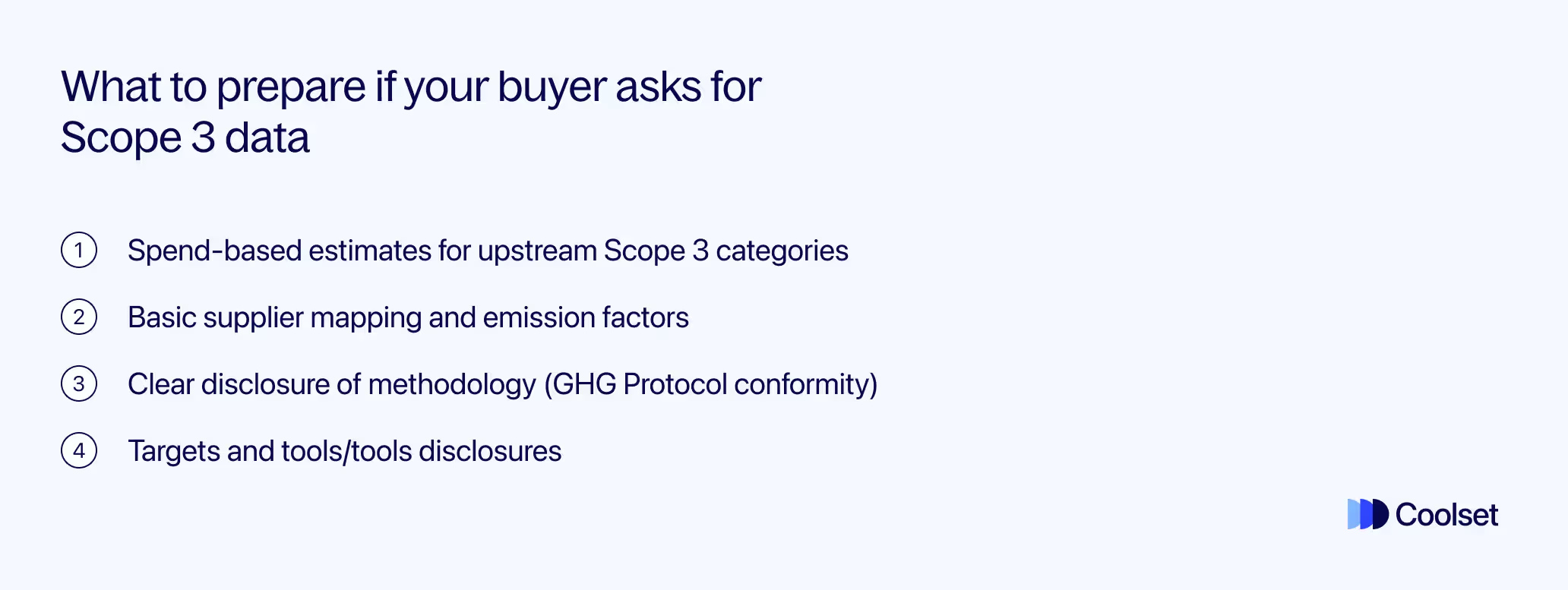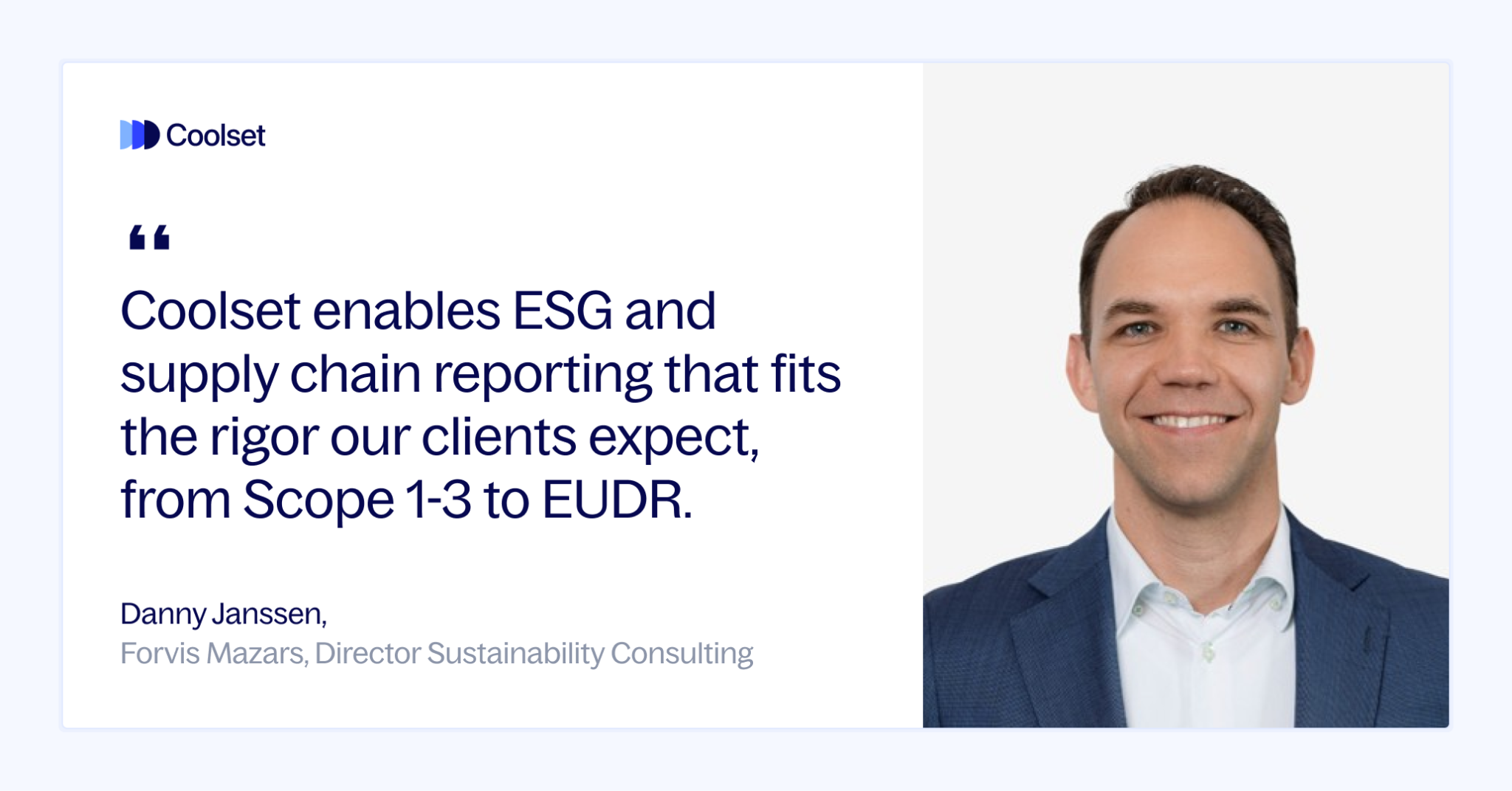Disclaimer: Latest EUDR developments
On 21 October, the European Commission proposed targeted changes to the EU Deforestation Regulation (EUDR). These adjustments aim to make the rollout smoother without changing the regulation’s overall goals.
Key points from the proposal:
We're closely monitoring the development and will update our content accordingly. In the meantime, read the full explainer here.
For mid-market companies, Scope 3 emissions reporting is quickly shifting from a nice-to-have to a non-negotiable.
In sectors like electronics, for instance, enterprise buyers like Apple and Siemens now expect their suppliers to measure and disclose Scope 3 emissions, turning it into a standard business requirement rather than just a voluntary initiative.
This shift matters most for companies that aren’t yet directly regulated but sit in the middle of complex supply chains. As larger firms work toward net-zero targets, they’re pushing Scope 3 responsibilities upstream. Can’t deliver the data? You may just be cut out of the deal.
The pressure isn’t just coming from buyers. Scope 3 emissions, which account for 70–95% of a company’s total footprint, are also central to key European climate regulations like the CSRD and CSDDD, increasingly scrutinized by investors, and a growing consideration in procurement decisions.
In other words, Scope 3 now touches every part of the equation: compliance, risk, and revenue. And for mid-market enterprises, the room to stay passive is shrinking fast.
This article breaks down what’s driving the shift, and how sustainability and operations leads can respond to growing demands from procurement teams, RFPs, and ESG questionnaires.
{{custom-cta}}
Let’s take a look at the main drivers behind the pressure to report Scope 3 emissions:
Under the EU’s CSRD, large EU-based companies defined as meeting at least two of the following criteria: over €50 M net turnover, €25 M in assets, or 250+ employees (i.e. most major buyers), must report value-chain emissions, including supplier data.
Even if the employee threshold changes to companies with 1,000+ employees, as proposed under the EU’s Omnibus, the direction is clear: major buyers are now expected to account for Scope 3 emissions across their upstream supply chain.
While the Science‑Based Targets initiative (SBTi) is not a regulatory framework, many companies pursue Science-Based Targets to demonstrate credibility in their decarbonization efforts and align with investor, customer, and market expectations.
SBTi requires companies to set Scope 3 targets if those emissions represent ≥ 40 % of their total scope 1, 2, and 3 footprint.
Tools like EcoVadis also play a key role. Often used as a sustainability “scoreboard,” EcoVadis helps companies benchmark ESG performance and meet procurement requirements from key customers.
Its Carbon Action Module and scorecards offer a structured way for buyers to assess supplier emissions, and for suppliers to differentiate themselves through transparency and climate action.
A 2023 BDC study showed that 92 % of major buyers were expected to require ESG disclosures, including Scope 3, from their suppliers as of 2024. As procurement increasingly demands carbon data, suppliers are bearing the reporting burden.
Buying giant Amazon, for example, scores itself based on supplier emissions. Fail to report in time? Amazon confirmed it will reconsider any given supplier partnership and seek alternatives.
Procurement teams are embedding ESG screening, including Scope 3 disclosure, into supplier evaluations.
A Deloitte/PwC study found 46 % of companies now require specific sustainability criteria from their vendors. Guides from EcoVadis also underline ESG data (carbon metrics, certifications, and targets) as essential for moving past procurement gates.
Gone are the days when Scope 3 data was just nice to have. Now every step, platform, and contract is being reshaped around it:
Enterprise buyers increasingly include questions about Scope 3 alignment in their Request for Proposals (RFPs) and vendor surveys.
Do you report Scope 1, 2, and 3 emissions? Are your emissions targets aligned with STBi? Can you provide a recent EcoVadis or CDP scorecard? RFPs now often include questions about emissions, ESG performance, and regulatory alignment.
Questionnaires from EcoVadis, CDP, and other ESG platforms now incorporate SBTi-alignment questions and carbon disclosure metrics, ensuring prospective suppliers are evaluated on emissions transparency and reduction strategies.
Digital procurement platforms are requiring carbon data during the onboarding process.
SAP Ariba and Sedex require early estimates of carbon emissions, Scope 3 included, as part of onboarding. Sedex now supports preliminary Scope 3 estimates directly within its environment.
In emissions-heavy industries, like logistics, chemicals, and heavy manufacturing, contracts increasingly include Scope 3 clauses. These cover obligations from emissions reporting to participation in decarbonization programs.
With the EU’s Carbon Border Adjustment Mechanism (CBAM) now in force, contracts are also rolling in provisions for CBAM compliance. These can range from embedded emissions data to cost-sharing and audit rights.
When a buyer requests Scope 3 emissions data, mid-market suppliers should be ready in four key areas:

A practical starting point is to calculate spend-based emissions for the upstream categories you directly influence, like Purchased Goods and Services (Category 1), Capital Goods (Category 2), and Upstream Transportation (Category 4).
This involves multiplying your purchase spend by industry-average emissions factors. It’s the approach recommended by the GHG Protocol for companies beginning their Scope 3 journey, especially when supplier-specific data is unavailable.
Because these categories are tied to your own procurement spend, data is relatively easy to extract from finance systems, and it gives buyers a clear view into how your supply chain contributes to your footprint.
Map your suppliers, segment them by spend or emissions intensity, and gather basic emission factors, either average defaults or supplier-specific ones where possible.
The GHG Protocol recommends a hybrid approach: start with spend-based averages, then progressively source more accurate data as you engage suppliers.
Buyers now expect transparency in how Scope 3 emissions are calculated.
Deloitte’s Digital benchmark of 1,300 B2B customers found that suppliers demonstrating “credible data and transparency” on carbon reduction (including Scope 3) build customer trust, loyalty, willingness to pay premiums, and longer purchasing commitments.
The GHG Protocol’s guidance insists on documenting the method used (spend-based, average-data, hybrid or supplier-specific) along with data sources, quality, and assumptions. This can help to boost credibility and comparability over time.
Be ready to explain whether you have emissions reduction targets, and if so, how you track progress.
Many buyers will ask which platforms you’re using (e.g., CDP, EcoVadis, SAP Ariba, DitchCarbon) or if you’ve set emissions goals aligned to science-based targets.
Staying in your buyer’s good books increasingly depends on how easily you can deliver verifiable Scope 3 emissions data. That’s where software becomes a must-have for compliance, credibility, and speed.
In fact, being proactive, i.e. having your Scope 3 estimates ready before you’re asked, can give you a competitive edge. Buyers are under growing pressure to evaluate supplier emissions quickly and consistently, so showing up with pre-calculated, audit-ready data can help you rank higher in the vendor pool and stand out during procurement reviews.
Modern carbon accounting tools make it easy to estimate emissions based on your existing financial or procurement data. These tools typically use spend-based or activity-based methods to automatically apply emission factors, categorize suppliers, and calculate Scope 3 emissions across key categories.
Spend-based estimates offer a quick, auditable entry point, especially useful for suppliers without primary data, but they are just that: estimates. As data quality improves, companies can layer in activity-based details (like quantity purchased, distance transported, or energy use) for more accurate and decision-ready insights.
Many enterprise buyers now require emissions data to be shared via platforms like SAP Ariba, EcoVadis, or custom procurement systems.
Carbon software helps you meet those expectations by generating clean, consistent reports in formats like PDF, Excel, and XBRL, and, increasingly, via direct API integrations. This means your data can seamlessly flow into buyer systems with minimal friction.
Best-in-class carbon tools come pre-aligned with leading frameworks such as the Science-Based Targets initiative (SBTi), CDP disclosures, and the EU’s CSRD regulation.
Instead of starting from scratch or wading through regulatory PDFs, teams can follow built-in templates, guided workflows, and preloaded emission factors to stay aligned with requirements. This approach saves time and reduces the risk of non-compliance.
Coolset is purpose-built for ESG, procurement, and supply chain teams who need to manage Scope 3 reporting and compliance with confidence.
Our carbon management module includes TÜV-certified Scope 1–3 measurement, supplier-level granularity, and seamless integration with frameworks like the CSRD, CBAM, and EcoVadis.

Here’s what makes Coolset a standout:
Built for mid-market enterprises: Coolset is powerful enough for enterprise-level demands, but intuitive for small or growing teams with limited resources.
{{product-tour-injectable}}
Let’s take a look at some of the most common questions around Scope 3 reporting.
Failing to supply Scope 3 data can hurt your standing in customer assessments, limit your competitive edge, and limit access to capital.
As a Berkeley article notes, suppliers who don’t report their Scope 3 emissions often receive lower ESG ratings. Only 21% earn top-tier ratings (AAA/AA), compared to 45% of reporting firms, which can raise their cost of capital and risk losing key contracts .
Yes, spend-based calculations are a recognized first step by the GHG Protocol. The methodology multiplies purchase spend by average emissions factors and is widely used in initial Scope 3 reporting.
Many platforms and frameworks accept this method, with the understanding that it should evolve over time to more accurate, supplier-specific data.
Category 1 (Purchased Goods & Services) typically form the bulk of a company’s Scope 3 footprint. It’s a primary focus for procurement because it directly links purchasing decisions to carbon impact.
Since scope 3 emissions can be up to 11.4 times greater than emissions generated by your own operations, buyers scrutinize this category heavily when assessing suppliers.
For buyers subject to EU regulations like the CSRD and CSDDD, asking for supplier emissions data is no longer optional, it can be mandatory. The CSRD requires value-chain reporting, compelling buyers to request Scope 3 data. The CSDDD even mandates action based on that data.
Even if your company isn’t directly covered by CSRD, your customers might be, and that’s where you come in. When they ask you for emissions data, it’s not just a voluntary request.
It’s increasingly aligned with the VSME regulation, which sets out minimum reporting expectations for smaller suppliers that fall outside CSRD’s full scope. That means even if you’re not a reporter, what you’re asked to provide is becoming more standardized, and harder to ignore.
Add to this the growing ESG requirements in procurement and RFP processes, and it’s clear: emissions data is fast becoming a default part of doing business.
EcoVadis integrates Scope 3 assessments, aligned with CSRD standards, into its supplier ratings and scorecards, prompting buyers to demand these metrics from vendors.
Under the CSRD, around 50,000 companies will need to report emissions, much of which depends on upstream data from suppliers, making EcoVadis scores and CSRD compliance two sides of the same coin.
Note: The number of companies impacted by the CSRD could drop to around 7,000 depending on the outcome of the EU’s Omnibus Proposal.
Related articles:
A practical guide to scoping, sourcing and calculating scope 1-3 data
